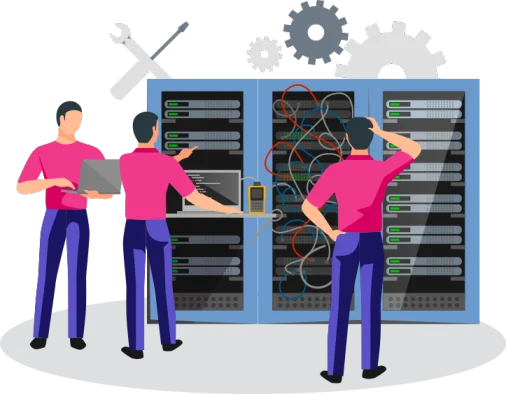| Linear Bus Topology | The devices are connected via a two-way link. All the clients need two network ports, one for input (receiving) and another for output (transmission), except at each end. In this type of topology, the flow of data is unidirectional. If a computer in the middle expects a message, the package must travel across the entire chain until it reaches its destination. |
|---|





Area Networks
Setting up and configuring network system, setting IP addressing techniques. Sharing and control of resources and internet connection over network. Creating Wi-Fi network. Networking security & Maintenance.
We design and construct computer networks for a variety purposes. These networks can range from small intranet connections to larger WANs and LANs.
Network design is a crucial aspect of any enterprise-grade network. The way a network is designed impacts your network monitoring capabilities and your overall system performance, making it as important a factor as the infrastructure itself. Your topology structure will be the foundation for conducting quality of service monitoring and troubleshooting, so having a strong awareness of how your topology works is crucial. As such, understanding your topology and how to design a network appropriately is key to your network’s success.
Network Design
Network Topologies
| Ring Topology | All the nodes connect to exactly two other nodes. So every node along the ring would need to handle traffic traveling across. These two nodes can be combined or via a switch. Ring topology is commonly used in the Metropolitan Area Network (MAN). |
|---|
| Bus Topology | This is also referred to as line topology (or backbone topology). It can be either linear or distributed. A bus network topology uses a single line of cable running from end to end. All devices on the network are connected directly to this single line (or bus), which is commonly a half-duplex link coaxial cable. In a bus topology, every host (or station) receives all traffic and has the same priority for transmission |
|---|
| Star Topology | It was influenced by the Spoke-and-Hub distribution model— a form of transport topology optimization. It started when traffic planners from passenger transportation and freight started to organize their routes as arrays of spokes connecting to a central hub. Soon, the efficient idea hit the IT sector, where they renamed it the “star network topology.” |
|---|
| Mesh Topology | The mesh topology can be either a fully or partially connected mesh network. In the entire mesh topology, all networking devices are directly interconnected in a non-hierarchical architecture. In the partial mesh topology, some devices are connected to many devices, while others are connected to only one or two. All these interconnected server devices work together to efficiently route data to and from distributed clients. |
|---|
| Hybrid Topology | Modern networks are rarely designed using a single type of topology. Instead, designers leverage the advantages from each topology and combine them. For example, hybrid topologies are made by combining two or more topologies such as bus, star, ring, or linear. |
|---|
| Tree Topology (Star+Bus) | The tree topology uses the parent-child hierarchy. It is also a hybrid topology— a combination of the star and bus topologies, where star networks are interconnected via a bus network. The core node (parent) provides “bus-like” connectivity to the other nodes, while the other nodes (child) expand the connectivity to their star topology. |
|---|
